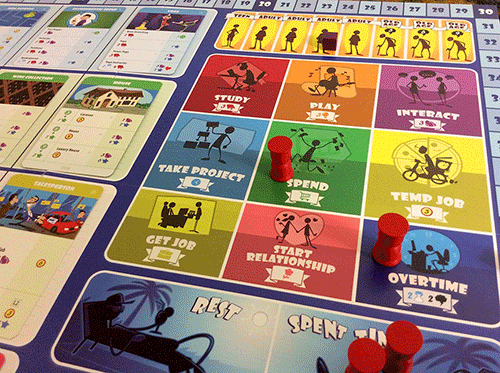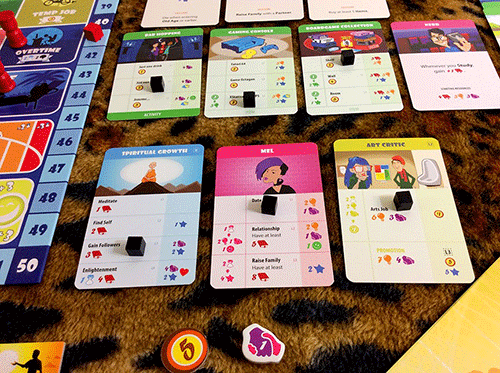The Pursuit of Happiness Review
on Oct 5, 2016
What is the true nature of happiness? Where does it come from? What makes a happy life? These questions have baffled western philosophers for millennia. Luckily, designers David Chircop, Adrian Abela and Vangelis Bagiartakis have solved this age-old conundrum.

The board is invitingly colorful.
As it turns out, a happy life can be attained by following a few simple rules:
1) There are exactly 5 sources of happiness: personal projects, leisure activities, material possessions, career advancement, and monogamous, childbearing relationships. Pursuit of Happiness is like many other European games: players draft cards and place workers to gather resources and convert them into victory points. Except here, the workers are your precious time, the resources are knowledge, creativity and influence, and the victory points are life's ultimate goal, long-term happiness. The cards represent different ways you might spend your time, from projects like acting or game design to items like a porcelain doll collection or an entertainment center to jobs and relationships. Happiness comes mainly from relationships, items and activities, although it's possible to gain it from projects and jobs as well (mainly through promotions).
2) Time is our most precious resource. Each player starts each round (roughly a decade) with 6 hourglass markers to spend. Time runs out surprisingly quickly, especially since jobs and relationships tend to eat up 2-4 of them before you've had a chance to act.You can put in "overtime" to gain additional hourglasses in exchange for stress, but this is a dangerous game: higher levels of stress cause you to lose even more hourglasses at the start of the round, and as your body weakens with age, stress will eventually kill you. (In Pursuit of Happiness's world, everybody dies from a heart attack.) As a teenager, before jobs and relationships become available, it seems like all you have is time, but the four decades of healthy adult life are chillingly fleeting.
3) You won't live to retirement. Rare projects and activities grant good health, which can lower your stress below certain thresholds and open you up to additional hourglasses. Unless you work very hard at improving your health and minimizing stress, however, you'll die by the second decade of old age, somewhere around age 70. The end is disarmingly rapid the first time you play, forcing you to adopt a more existential philosophy. If you want to win, you'll squeeze every moment for all it's worth.
4) Money does buy happiness. It's appropriate that the game's name comes from a U.S. founding document, because it espouses a particularly American view of personal success. You might find a few moments of fulfillment through yoga and poetry, but the quickest road to happiness is to follow the American Dream: getting stinking rich. No form of self-betterment can compare to owning a really nice car, traveling the world, or building a giant board game collection.
5) Short-term euphoria gives you superpowers. A lot of projects and activities pay out in short-term happiness, which lets you literally bend the laws of time and space. You can complete projects without putting in the printed resources. You can refresh the card offer, making your own prospects. And the person with the highest short-term happiness becomes the next round's first player.

Bar-hopping nerd art critic or yogi dentist? The choice is yours.
6) You can do exactly 3 things at a time. This is another reason items and activities are the most efficient path to happiness. Projects, relationships and jobs each take up one of your three invisible slots. Take on a fourth hobby, and you'll start to go a little crazy, increasing your stress levels. Polygamy is a double-whammy—maintaining two relationships simultaneously could put anybody in an early grave.
7) Jobs suck...but how else are you going to maintain your record collection? The most fulfilling items have recurring costs—and recurring payouts. If you can't pay to maintain your collection at the start of a round (roughly a decade), you lose it—and get one step closer to death by myocardial infarction. So you'll need a steady source of income. Luckily, there are jobs. Unluckily, all jobs suck, and the best-paying jobs suck the worst. Entry-level jobs take 1 of your 6 hourglasses, along with some resources, while the exec-level positions absorb 3 hourglasses, fully half your lifetime.
8) Relationships are non-optional. Starting a long-term relationship eats up even more of your time, but it can give you the resources needed to perform your job (being fired is never fun). Starting a family takes even more time and robs you of that consistent source of inspiration, replacing it with a sizeable, recurring payout of long-term happiness. Aside from being a clever gameplay mechanism, it's a brilliant philosophical statement: having kids is a lifelong payoff, but that life is no longer your own.
The Pursuit of Happiness is a very clever game. As a resource-management Euro, its self-limiting mechanisms, the sense that jobs and relationships can literally take over your life, provide a great replay hook as you're constantly trying to improve your own efficiency under changing conditions The card decks and life goals are varied enough that each game feels like a unique puzzle. As a life simulation, it's not as in-depth as computer sims like Alter Ego and, well, The Sims, but it's a lot more insightful, and you come away from the game with a new appreciation for your life outside of it.

 Customer Support
Customer Support  Subscribe
Subscribe 




 Account
Account  Wishlist
Wishlist 
